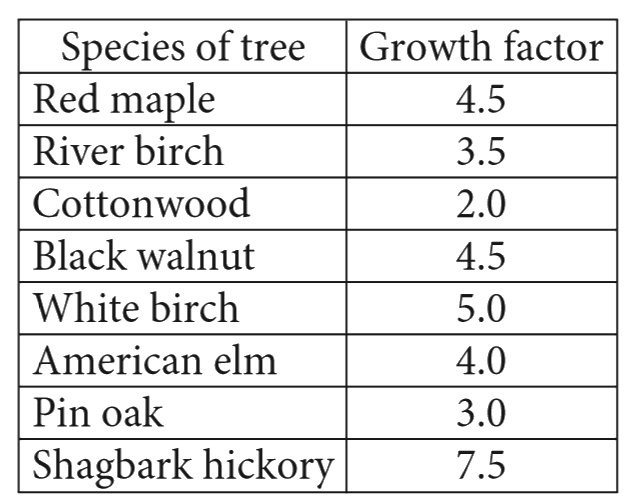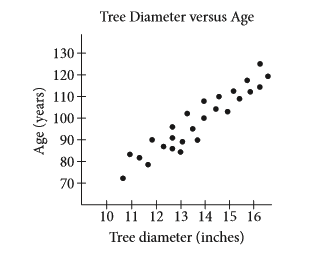
One method of calculating the approximate age , in years, of a tree of a particular species is to multiply the diameter of the tree, in inches, by a constant called the growth factor for that species. The table above gives the growth factors for eight species of trees.

The scatter plot above gives the tree diameter plotted against age for 26 trees of a single species. The growth factor of this species is closest to that of which of the following species of tree
Red maple
cottonwood
White birch
Shagbark birch
Step by step video & image solution for One method of calculating the approximate age , in years, of a tree of a particular species is to multiply the diameter of the tree, in inches, by a constant called the growth factor for that species. The table above gives the growth factors for eight species of trees. The scatter plot above gives the tree diameter plotted against age for 26 trees of a single species. The growth factor of this species is closest to that of which of the following species of tree by Maths experts to help you in doubts & scoring excellent marks in Class 12 exams.
Updated on:21/07/2023Similar Questions

One method of calculating the approximate age , in years, of a tree of a particular species is to multiply the diameter of the tree, in inches, by a constant called the growth factor for that species. The table above gives the growth factors for eight species of trees.
According to the information in the table,what is the approximate age of an America nelm tree with a diameter of 12inches
View Solution
One method of calculating the approximate age , in years, of a tree of a particular species is to multiply the diameter of the tree, in inches, by a constant called the growth factor for that species. The table above gives the growth factors for eight species of trees.
If a white birch tree and a pinoak tree each now have a diameter of 1 foot,which of the following will be closest to the difference,in inches,of their diameters 10 years from now?(1foot=12inches)
View Solution
Knowledge Check
Tree of life is
Abranchial treeBlymphatic systemCarbor vitaeDloop of henle.Bark of a tree consists of:
Aall dead tissuesBall tissues outside the vascular cambiumCall tissues outside the cork cambiumDthe cork and secondary cortex
